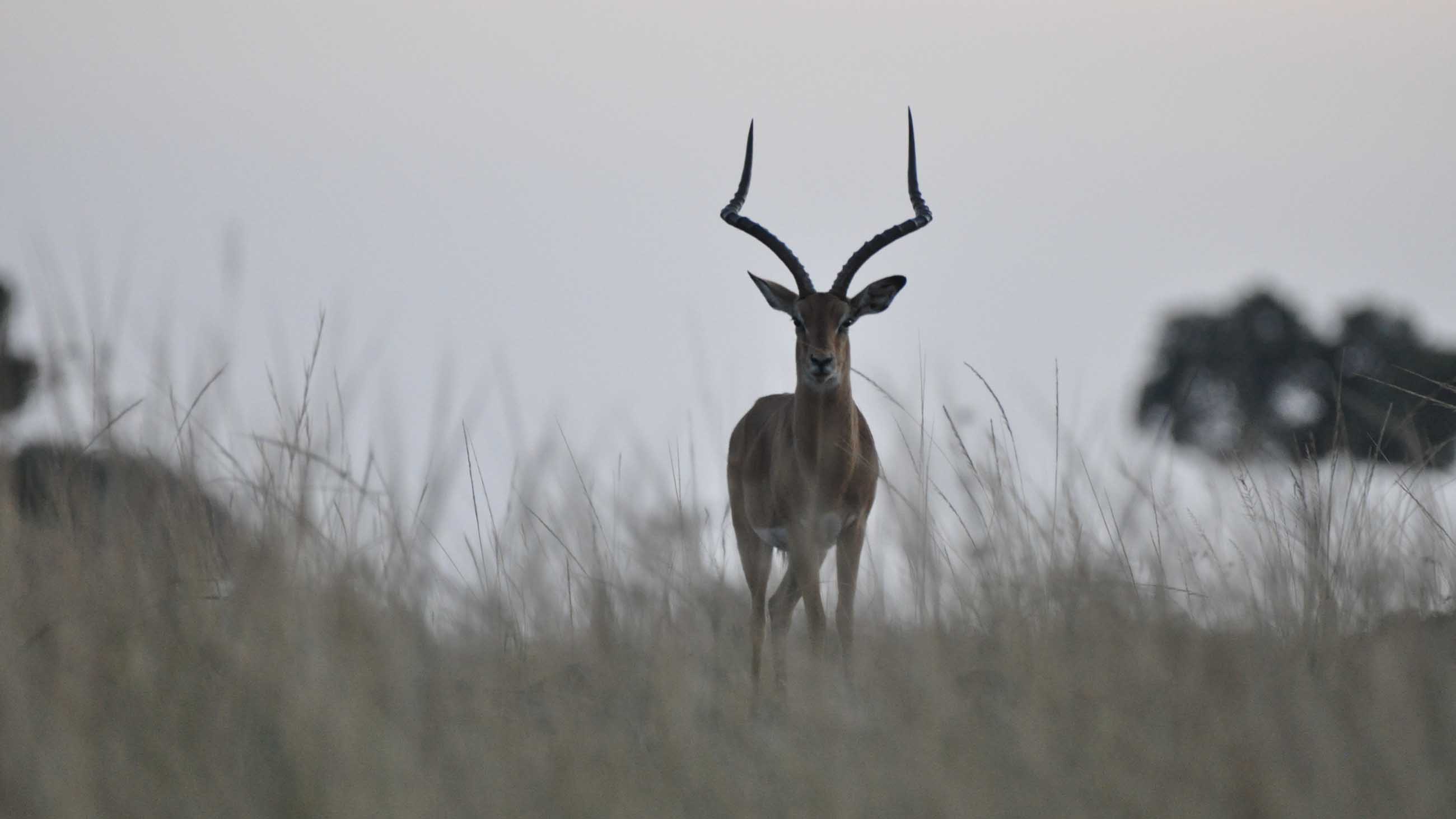Did our stone age ancestors chase down antelope across the hot, dry savanna, armed with nothing but maybe some blunt sticks or rocks, for hours on end, never letting the animals rest until they collapsed with exhaustion, and the hunters, glistening with perspiration, could go in for the kill?
Probably not.
The idea of ancient humans as persistence hunters, possessed of superior physical capability, has a certain romance about it and has become very popular with running enthusiasts. Some scientists suggest it can explain several of the evolutionary traits humans have acquired over the past 2 million years. There may be some groups who practice it even today, though that’s hotly debated.
Despite the idea’s foothold in popular culture, however, there is no hard evidence that ancient humans were persistence hunters, much less that persistence hunting shaped evolutionary traits. In fact, what evidence there is doesn’t support the notion that early humans acquired their meaty meals through feats of running endurance; it flatly contradicts it.
The theory that persistence hunting played a crucial part in the evolution of man was first suggested in 1984 by David Carrier, who at the time was a doctoral student at the University of Michigan. Carrier’s idea was based on the observation that man is one of the only mammals that cools itself by sweating. Most four-legged mammals pant to cast off heat, which doesn’t work nearly as well when running. Carrier concluded that if our early human ancestors could chase an animal long enough, the animal would overheat and collapse with heat exhaustion, and the humans could step up and dispatch it easily.
Carrier’s idea was picked up and advanced by the Harvard paleoanthropologist Daniel Lieberman. “As for anatomical, genetic, and paleontological evidence, there are so many derived features of humans that make us good at running and which have no other function, they clearly indicate humans were selected for long distance running,” Lieberman wrote in an email. He has noted that those features — arched feet, short toes, wide shoulders, long Achilles tendons — seem to have originated around 2 million years ago, around the time when the genus Homo evolved and our ancestors began making meat a regular part of their diet. Persistence hunting, he’s argued, might have been the evolutionary driver.
Eventually, Lieberman’s ideas came to the attention of the popular author Christopher McDougall, who wrote about the theory in “Born to Run,” his bestselling 2009 book about endurance running. McDougall argued that the features identified by Lieberman explain why we like to run marathons, even ultra-marathons, and are fairly good at it. When we run distances, he implied, we are fulfilling our biological destiny. The running community, and the public generally, have embraced this idea wholeheartedly.
But the idea is a supposition. It was formulated as a way to explain characteristics humans possess. The best evidence for humans engaging in persistence hunting is merely that we have physical traits that suggest we could do so.
Henry Bunn, a paleoanthropologist from the University of Wisconsin-Madison, has said more than once that a person would have to be “incredibly naïve” to believe the persistence hunting theory. Bunn recalls that he first heard discussion of the theory at a conference in South Africa, and he realized almost immediately that if you are going to chase an animal that is much faster than you, at some point it will run out of sight and you will have to track it. Tracking would require earth soft enough to capture footprints and terrain open enough to give prey little place to hide and disappear.
When he heard of the idea, Bunn had just been in the Great Rift Valley of East Africa, one of the areas where it is thought that Australopithecus, our first upright walking ancestor, evolved into the first of the human genus. He knew the terrain was probably not soft during the time period discussed by the persistence hunting theory. And it was mixed savanna woodland, not open plain. It’s highly unlikely that primitive humans would have been sophisticated enough to track under those conditions, Bunn and his co-author, Travis Pickering, also of the University of Wisconsin, argued in their first paper questioning the persistence hunting theory.
Plus, Bunn had spent time with the Hadza, a modern-day group of people in the Great Rift Valley who are thought to live much like their ancient ancestors did. The only time Bunn ever knew the Hadza to run was when they were fleeing pelting rain, angry bees, or marauding elephants — and maybe occasionally to scavenge.
Bunn and Pickering also knew there was relevant fossil evidence: a pile of bones from the very time period in question — 1.8 million to 2 million years ago — found in the Olduvai Gorge in Tanzania. The bones were discovered by Mary Leakey, the same archeologist who, with Louis Leakey, found a 1.8 million year old hominid jawbone that was once touted as the “missing link” between apes and humans. The pile contained bones of ancient waterbuck, antelope, and wildebeest that had been gathered by an early Homo group for butchering and sharing among them. Some of the bones had marks where rock choppers were used to cut the meat off.
Bunn recognized a golden opportunity. “We don’t usually get such clear-cut evidence to test something from 2 million years ago,” he said. He and Pickering thought that if they could age the different animals in that collection, they could glean whether the animals were scavenged, persistence hunted, or hunted some other way. If the animals had been scavenged or captured by persistence hunting, they likely would have been either very young or very old. Savanna predators like lions and leopards don’t chase the healthiest, fastest animals of a herd — and presumably persistence hunters wouldn’t either. Rather, they’d chase the ones that are easiest to catch.
But the researchers found that most of the animals in the collection were either young adults or adults in their prime. Of the 19 animals they could identify, only four were very young or old.
To Bunn and Pickering, that suggested the animals hadn’t been chased down. And because there were butchering marks on the bones with the best meat, it was also safe to assume that animal carcasses hadn’t been scavenged by humans after being killed by other predators; the predators surely would have taken the prime portions for themselves.
Instead, Bunn believes ancient human hunters relied more on smarts than on persistence to capture their prey. In his paper with Pickering, he suggests that our ancestors would wait in brushy, forested areas for the animals to pass by. They may have even hidden in the branches of trees, since hooved animals tend not to look up. That would have allowed the hunters to get close enough to club the animal with a sharp object.
It’s not entirely clear what that sharp object would’ve been. Sharpened wooden spears don’t appear in the archaeological record until about 400,000 years ago, and stone tipped spears didn’t appear until much later. But this much is clear, Bunn said: “In terms of the hard, archaeological evidence, persistence hunting is just flatly contradicted.”
And then there is the horse race.
Back in 1980, two Welsh men were sitting in the Neuadd Arms Hotel pub in Llanwrtyd Wells, Wales, arguing about who was faster over long distances, man or horse. Before the dispute came to blows or bitterness, they decided to settle the question with an actual race, one of 22 miles. The race was such a spectacle that it has become an annual event, each year attracting hundreds of humans and dozens of horses.
Now, there are a number of reasons why this is an imperfect test of the persistence hunting theory. Compared with most mammals, for instance, horses are actually fairly good endurance runners. And Wales is cool, not hot like the African savanna. But it is also true that the course is intentionally laid out to give the human the advantage.
So, how many times has a human won?
Twice. In 40 years.
If the prize were a meal, the humans would be starving.
Timothy F. Kirn is a freelance writer based in Sacramento, California. He was formerly an assistant editor at the Journal of the American Medical Association, a reporter for the Rochester Times-Union in New York, and an MIT Knight Science Journalism fellow.












Comments are automatically closed one year after article publication. Archived comments are below.
The Hadza’s subsistence methods are a complete non-sequitur when it comes to whether or not ancient humans practice persistence hunting. The French do not practice persistence hunting either, but this has no bearing on whether or not ancient humans either. The fact that the Hadza live in Africa and appear “primitive” to the author does not make them an ideal model of prehistoric human behavior. If this were true, one could draw the exact opposite conclusion by observing the !Kung people in Namibia.
There is more “whataboutism” and jumping to conclusions in this article than I care to spend debunking.
This entire article is a joke due to its unprofessionalism and lack of any diverse research. The author clearly wrote this with confirmation bias, starting out with a preconceived belief and only researching (or at least presenting) information which supports his theory, information which falls apart when faced with the slightest scrutiny.
For example, the fact that the Xo, Gwi, San, !Kung, Raramuri and Indigenous Australians have all been documented to utilise persistence hunting to this day, the fact that there are three types of tracking – Simple, Systematic and Speculative – which persistence hunters can use to track animals through woodland and over solid earth, and the fact that the Bulls of foraging animals like Kudu will have the heaviest horns, meaning they are the ones that will tire fastest and as such would be targeted by early hominids – something Bunn and Pickering seem to have overlooked (or if they didn’t, they certainly didn’t address it, at least according to this article).
The fact this is the second link, and first article, that comes up when you google “Persistence Hunting” is a crying shame, and it’s even more of a shame that so many journal websites have quoted this erroneous article, perpetuating the idea that journalism has gone completely down the drain.
This author ignores the fact that humans still practice persistence hunting to this day in many tribes. He also proceeds to compare men and horses racing each other. One of the very few animals we can’t outrun as they have large enough sweat glands to sweat the same way humans do; cooling themselves just as fast as us. He should have compared humans racing cows, pigs, dogs, deer, apes, you name it. But no, he rather talk about the exception.
I do not understand his motives behind this article. He’s not debunking anything, but his capacity to truthfully research.
I also love how he summarizes the humans vs horse race by focussing on how many times a human has won. For there to be a meal, we wouldn’t have to win the race, the humans just would have to out run a single slow horse. From the records I could identify, for as long as that race has occurred, there’s been a human come in before some entered horse. We’d be eating just fine.
How then to explain the various physical adaptations that are only useful for distance running? Why are we the only ape with an Achilles tendon? It won’t help us out-sprint a lion, but could help us out-last a spring bok.
“the best meat.” This was not the muscle meat. Early Homo was after organ meat, glands, marrow, and brain matter, which did not need to be cooked. Very high fat and nutrient concentration. So any conclusions depending on “best meat” are erroneous if you mean tenderloin and haunch.
No evidence of cooking for at least a million years after bipedalism and switch to fat adaption rather than carbs.
We don’t have to speculate. We know humans persistent hunt because it’s been observed many times. There are tribes left that continue with the practice: the Xo and /Gwi tribes in Botswana, the San people in the Kalahari Desert, the !Kung Bushmen of Namibia, Hadza in Tanzania, the Rarámuri people of Northwestern Mexico, etc.
A few generations ago, Native Americans in Texas were still persistence hunting. But that becomes impossible when put on reservations. There are many historical accounts of persistence hunting. For example, there are accounts of Australian Aborigines tracking animals (and humans) while running.
“early people weren’t smart enough to track animals they were chasing”
2 paragraphs later:
“early people likely caught the prey by outsmarting them”
It seems that the author has chosen a verdict, then tried to justify it.
Factually there are still tribes that practice this. Go to southern Kenya, northern Tanzania, for example and you can witness this practice for yourself.
Same in the Kalahari.
Yes, they also need to be good trackers.
That is key against animals such as wildebeest, gnu, maribou, impala ss examples.
Gooday, I once ran down a half grown pig in NSW, Australia. My father used to tell me that they did this sometimes when he was young. One day when we were out shooting pigs I decided to try it. Chose a half grown pig and then just ran slowly behind it to keep it moving. After about a kilometer or so it stopped and turned to face me. I just moved quickly around it until I could grab a back leg. I then had it. If I had a spear I could have killed it. Greg
Going to dismiss the article as science or truth. Article says there’s no hard evidence then goes on to say the “theory of”. A theory is infact enough evidence to conclude a subject. It isn’t just an opinion is factually represented.
I am a UK livestock farmer, now aging. When I was fitter in my 50’s it would take me about 15 minutes to run a young cow down till she slowed for a rest
I have seen the San bushmen of the Kalahari run down an animal over a long distance on Youtube. Are you suggesting the footage is fabricated? They were filmed by David Attenborough no less. Is he in on the plot?
I was about to post the same video, but also this link: “Kenyans chase down and catch goat-killing cheetahs” https://www.bbc.co.uk/news/world-africa-24953910
Hunting the animals in their prime may have actually been an advantage. Other predators chase the old and young because they are slower in a sprint but a primary component to persistence hunting is heat. The larger animals in their prime may have been easier to catch persistent hunting if they overheat faster.
Exactly. P
One if the key adaptations for this practice that humans have is our lack of body hair, and sweating from the entire body surface. This gives a huge advantage in hot locales.
Early humans might have had a slight advantage over other animals in certain conditions when running.
Early humans had a huge advantage over other animals in all conditions with intelligence. That probably points to hunting via ambush, chasing off cliffs, using fire (perhaps later) etc.
I think a lot of people who are attached to persistence hunting are either runners (hey, I am too) or just like the idea that we can do something physical better than other animals.
I wondered about this so looked up Timothy F. Kirn’s qualifications.
He apparently has NO tertiary qualifications in anything (or not that he admits to), but was a sub-editor of a Medical Journal.
“He apparently has NO tertiary qualifications…”
What, exactly, is a “tertiary” qualification, as opposed to, say, a primary qualification or just a plain old “qualification”?
Not commenting on whether he’s right or not, but ‘tertiary’ means university/college. Primary means primary school (I think this is called ‘elementary school’ in the US), secondary = high school, tertiary = post-high school. A quick google suggests tertiary education might be called ‘higher education’ in the US??
But anyway yeah he’s saying the guy doesn’t have a degree. But he checked the writer – who is a communications person – not the scientists involved, so it’s not really relevant.
Timothy Kirn is a writer / communications professional. It doesn’t matter if he has a relevant degree, he’s reporting on research, not doing the research himself.
He’s citing research from Henry Bunn, a paleoanthropologist, and Travis Pickering, who both do have tertiary qualifications. Their article on this is in a peer-reviewed journal: https://www.sciencedirect.com/science/article/abs/pii/S0047248407001327
Getty Images has two video clips from an 8 hour hunt of a Kudu in the Kalahari where the antelope was chased to exhaustion and then speared as described by in a previous comment. I’ve seen another picture of this type of hunt with a different antelope standing in exhaustion unable to run any further. Pretty sure it was in National Geographic. Link: https://www.gettyimages.com.au/detail/video/kudu-antelope-collapses-from-exhaustion-as-san-stock-video-footage/1B05614_0046?uiloc=thumbnail_same_series_adp And I found an 7 minute video of what is likely the source of the Getty clips on Youtube. https://www.youtube.com/watch?v=826HMLoiE_o It was a BBC film about the San Bushmen of the Kalahari and specifically about persistence hunting…
Dr Bunn had evidently never actually seen an animal hunted in Africa. They don’t run over the horizon, they run a short distance until they feel safe. Then they stop and look back. As the pursuer nears, they begin running again. As any runner will tell you, this constant changing of pace will exhaust the prey far faster than the hunter.
Furthermore, the tracking skills I’ve seen demonstrated by Khoi San in Southern Africa, one of the modern groups who do, in fact, still employ this technique, are nothing short of phenomenal. And Northern Namibia and Botswana, their territories, are by no means cool.
Can’t recall exactly but I saw a documentary in wlhich a film crew followed a hunter in the Kalahari who did in fact run down some kind of antelope. In the end it was lying on the ground, exhausted; he apologized to it and then killed it. Of course it ran out of sight repeatedly, but he was able to track it on hard ground — not only is it easyi to guess where an animal will go, but there are countlesss documented cases of people, from native Americans to modern expert trackers, following what seems to you and me like invisible traces. I have personally been able to follow deer scent a short distance under good conditions.
The Khoisan people of the Kalahari do chase down their prey normally antelope, however this normally follows after they have shot the animal with a poisoned arrow. They are one of the few stone age people’s left in the would and are more master trackers than persistence hunters. The animal doesn’t become exhausted from running the poison just takes a while to take effect.
I saw the same. And the most common sense assumption is that early humans hunted animals any way they possibly could. When ambush made sense, presumably that is what they did. If persistence hunting was possible and energetically advantageous, then why not. The human potential for distance running is without a doubt the greatest among mammals. A horse can beat a good runner over 22 miles, sure. But what about over 100? Or 150? I’d put my money on the ultra-marathon runner or a Tarahumara runner over the horse at very long distances. Whether persistence running was common is certainly a good question. What isn’t in doubt, however, is that humans are built to cover great distances at a slow speed. Whatever the precise evolutionary history of the many traits that allow for this, it is simply the case that we were born to run and we do it exceedingly well.
It doesn’t have to be one or the other. Using their smarts they tried to deliver a mortal strike to an animal but with unsophisticated weapons rarely being able to kill immediately, they then followed the wounded animal until it fell. We haven’t changed and still prefer to always take the easiest way.
Horses had been breed by humans for endurance. They are the absolute worst animal to test for this hypothesis.
Horses were the oil industry of pre industrial civilization. They had to endure long distances, move armies and cargo. The weak one died.The strong ones were breed.
That’s why horses are not at all a model for an antelope to be hunted by exhaustion.
Horses sweat, antelope and other prey animals don’t, so the horse/human race proves nothing. Seems more likely that early humans first injured animals along known trails, then running an injured animal to exhaustion. Don’t underestimate the tracking skills of indigenous peoples either…rocks moved, grass blades out of place, perhaps even scent and sound. Many wilderness backpackers, self incuded, have experienced a state of heightened senses after a time on the trail alone and away from the sense-numbing cacophony of modern civilization.
but lions dont sweat so using them as an example doesn’t work.
from the write up I don’t see how persistence hunting is a myth
Meh. Your headline and intro oversell your evidence. You’ve certainly not established that persistence hunting is a myth — merely that it has evidence against it as well as for it. You’ve made assumptions about the way persistence hunting works, which may not be valid. You’ve made assumptions about what East Africa looked like 400,000 years ago, which may not be correct. You’ve drawn a lot of conclusions from one pile of bones, aided by supposition of the parallels between human and big cat hunting. It’s enough to argue that the case is far from closed, and you could reasonably say you have given reason to be skeptical of the hypothesis. But you are a long way from being able to conclude you’ve shown it’s a myth.
This is the kind of breathless overselling that ruins the reputation of science journalists.
Well put. Am I more skeptical now than I was after reading Christopher McDougall’s book, ‘Born To Run’ (a great read, btw; changed my whole approach to running…and walking for that matter)? Yes. Is persistence hunting demonstrably debunked here? No.
I concur. I especially disagree that persistence hunters would choose to hunt the weak or old. A muscled prey in its prime might well reach heat exhaustion quicker…and a smart hunter employing this tactic would seek the best possible reward/effort ratio. This is supposition on my part, and so too is that of the researcher.
Very interesting perspective and well written
Paleolithic hunters, were probably even more effective gathers than they ever were hunters and while small game is evasive and hard to catch big game is dangerous unless it can put into a situation where man has the advantage. I would suggest that man chased only wounded game and was an opportunist in his hunting endeavors. At most they used a stone tipped spear which was more of a defensive weapon than an offensive weapon usable and only at very short range resulting in close contact with the prey. They would have been more successful if they funneled prey by erecting obstacles to their escape that directed them into a location where a hunter armed with a spear could effectively take down the animal at very short range with minimal risk to himself. Man would have been inclined to use traps and dead falls more often because they didn’t require his attention and multiple traps could be used at once more effectively than a single hunter at any one location.
Primitive humans were probably a lot smarter than we give them credit for. It would be ludicrous to expect them to waste any more energy than they had to when obtaining their food. The calorie math of running after big game just doesn’t make sense. Ambush hunting makes sense. Driving prey into rivers where they can be more easily slaughtered makes sense (in fact, I know someone who hunts feral pigs that way). Like you said – trapping – makes sense. I also question whether their tracking skills were as bad as the Henry Bunn assumes. A child, brought up in a primitive environment, would have no trouble tracking in soft earth. By the time that child reached maturity, following trails on harder substrates would be second nature. While this would equip them with the skills to follow their quarry, it would also allow them to know where they were going to be. Animals are like any modern human who follows habituated routes to work, the supermarket, etc. Game uses the same trails over and over again. Knowing that, it’s not that much of a leap to expect that humans could set up shop and meet them when they came sauntering back.